|


Be on the wave or under it™
The News – 09/24/02
|
In this Issue:
|
Recommended Reading
|
|
|
I realize this is the only
newsletter you’ll ever need, but if you want more in-depth
detail, check out:
Stan Hustad’s
The Coaching Connection
Management Signature's
The Express Read
|
Fiber to the Home? It’s Happening
The second part of the Why
You Need to Get Hip to HIPAA series will appear in a future
SNS
And they said it couldn’t be done. Well it not only could, it
has been: Grant County, Washington, is running a Fiber-To-The-Home
(whose acronym is the virtually unpronounceable FTTH) project
that will offer, among other benefits, “lightning fast connections
to the Internet, digital television including Video-on-Demand,
and telephone service, which may include extended calling areas.”
Holy Moley!
It’s called the Zipp Network (Zealous Innovators of Public Power),
and it has already wired, among other county areas, the good folks
who live on Electric Blvd. in Electric City (I am not making this
up. Grant County does not include the nearby hamlet of Bagdad
Junction, however.)
The Zipp Customer Care Team polled 6,400 households and businesses
within the county and found that 78 neighborhoods or “hubs” met
the PUD’s (Public Utility District) participation requirements
for placement on the Zipp construction schedule. More than 2,000
customers were wired by this past April, making this one of the
largest fiber-to-the-home construction projects in the world with
more than 12,000 strand-miles of fiber. When complete the network
will connect 36,000 homes and businesses over 47,000 miles of
fiber at an investment of $120 million. The project is scheduled
to connect 6,000 homes by the end of 2002. Construction will continue
through 2005.
Despite some initial challenges with sound quality and synchronization,
Zipp is now successfully delivering digital TV service from two
separate carriers. Customers also have a choice of 11 Internet
providers, but only one telephone carrier.
Not only do customers get a lot of choice, the services are cheap.
Prices range from $21.95 to $30 per month. It’s also fast, 1500
KBps. Heck, the system even reads your gas and electric meters.
So what made all this possible? How did this rural county hard
by the Grand Coulee Dam and 60 miles from Spokane do something
that the huge, whiny telecom giants
have been unable to do?
David Isenberg, in his SMART Newsletter, prints a letter from
William G. "Skip" Malette, II that explains how an innovative
law made this type of development possible in Washington State.
Malette, a member of the telecommunications committee of the
Kitsap County Economic Development Council said:
Two years ago the Washington State legislature
put into a law a provision to allow Public Utility Districts and
Rural Port Districts to build fiber infrastructure as wholesale
providers. As a result the state association of PUDs formed a
non-profit organization to build and maintain a statewide backbone
to link all the PUDs together. This backbone, known as NOANET,
also provides a link the Internet at the primary interconnect
in downtown Seattle. Most of the PUDs are electric utilities and
can justify running fiber to the home as part of their operational
needs. The biggest PUD in this effort is in Grant County and has
done most of the pioneering effort.
In Malette’s county, Kitsap, the local water utility is the PUD
and it recently lit a new publicly owned 33-mile fiber-optic connection.
For FTTH, homeowners will fund the construction of the “last mile”
through a Local Utility District (LUD), which makes a special
property tax assessment. Property owners can pay off the assessment
over as many as 20 years. Interestingly, the homeowner actually
owns the resulting connection, which is a fabulous idea because
it allows the property owners to set up a management structure
through the LUD and retail to themselves, according to Malette.
Coe Hutchinson, fiber business manager at the Grant County PUD,
expects an ROI of 15 to 20 years. “For a lot of private businesses,
that can be pretty tough,” he said. “But for a utility that's
used to investing in hydroelectric dams, that's pretty reasonable.”
The PUD earns money by charging service providers: ISPs pay $15
a month for a 1 Mbps connection, while a 10 Mbps connection is
$25 a month. The PUD has price scales for connections all the
way up to a gigabit-per-second.
Other states are getting into the act, including the Truckee
Donner Public Utility District in California. Irvine, California-based
utilities company Competisys
recently partnered with Schuler Homes to deploy a direct fiber
Gigabit Ethernet connection to each new home in Schuler’s Poppy
Meadows community in American Canyon, California. The utility’s
HomeStream Direct-Fiber Gigabit Ethernet System uses Minerva
Systems’ IP television headend. Gigabit Ethernet, at 1 billion
bits per second, is significantly faster than the speed of the
Grant County project, to say the least. South Carolina’s Horry
Telephone Cooperative is also delivering services over FTTH.
In Minnesota, HomeTown Solutions signed a $2.7 million contract
with Minnesota-based OpticalSolutions way back in May, 2000 to
wire 1,500 homes and commercial buildings in tiny Morris, Minnesota.,
with OpticalSolutions' FiberPath system. The homes were to be
wired even if homeowners and businesses had not yet signed up
for the service. The service isn’t cheap, however, with 512Kbps
costing $79.95.
In June, the wonderfully named World
Wide Packets, a vendor in the Grant County project, held a
conference entitled “Community Networks 2002: Negotiating the
Path to Success” attended by 100 representatives of 70 communities.
Incidentally, WWP has trademarked the term Fiber to the Subscriber™
(FTTS™), which is infinitely more pronounceable than FTTH.
Overseas, there’s lots of FTTH progress as well. NovaMedia is
delivering live TV channels and Video-On-Demand (VOD) over Iceland’s
widespread fiber network to almost 20,000 households. GoldTV,
a provider of broadband television services based in Milan, Italy,
is using an extensive Fiber-DSL network to deliver broadcast quality
live television and VOD services to residences in the Lombardy,
Emilia-Romagna and Veneto regions of northern Italy.
There’s even an industry organization promoting “last mile” connectivity,
although they term it, more properly, the first mile. Ethernet
in the First Mile (EFMA)
encourages the utilization and implementation of Ethernet to the
home and works with the IEEE P802.3ah Task Force to develop standards.
They’ve got a white
paper that paints a much rosier broadband picture than the
one we’re getting from the battered telecoms these days. Another
industry organization, the Fiber
To The Home Council, will host its first ever conference in
New Orleans in October. The FTTH Council (FTTHC?) said in a recent
report there
are 50 communities in 16 states implementing FTTH.
So why doesn’t your house have a fiber connection? That’s probably
a good question to ask your state public utilities commission
and your legislature. I’ve written before
about how ADC’s CEO Rick Roscitt is whining about the lack of
a national broadband policy. Perhaps the real answer is a lot
closer to home than Washington, DC. And perhaps the real answer
involves empowering consumers and public ownership of the networks.
SMART Letter
Briefly Noted
- Shameless Self-Promotion Dept.: SNS
is two years old! Pop a cork! See the Wayback Machine below
for info on the first issue.
I’ve put up the Nanotechnology
Resources directory.
Also, check out the article I wrote for the Taylor Harkins newsletter
entitled, Do you hate your customers?
It continues the theme from my earlier article, analyzing
the media industry’s response to file sharing. My next article
for them will be on Short Messaging Service (SMS), so watch
for it soon.
Finally, the CTOMentor wireless white paper, You Can Take
It with You: Business Applications of Personal Wireless Devices,
is available at ITPapers.
-
Yet Another Overwrought Jack Valenti
Quote: In a previous SNS, I noted
that Jack Valenti lacks a certain
perspective on the whole file sharing phenomenon. It turns
out that he has a history of histrionics. In testimony before
the US House of Representatives Subcommittee on Courts, Civil
Liberties and the Administration of Justice on April 12, 1982,
Valenti declared: “I say to you that the VCR is to the American
film producer and the American public as the Boston strangler
is to the woman home alone.” You gotta admit, that’s way more
out of control than calling file pirating “an outrageous despoilment
of precious assets.” Gee, the movie industry has made billions
on videos played by those same VCRs. I guess the question
is, is Jack over-reacting, or just overacting? Valenti lacks a certain
perspective on the whole file sharing phenomenon. It turns
out that he has a history of histrionics. In testimony before
the US House of Representatives Subcommittee on Courts, Civil
Liberties and the Administration of Justice on April 12, 1982,
Valenti declared: “I say to you that the VCR is to the American
film producer and the American public as the Boston strangler
is to the woman home alone.” You gotta admit, that’s way more
out of control than calling file pirating “an outrageous despoilment
of precious assets.” Gee, the movie industry has made billions
on videos played by those same VCRs. I guess the question
is, is Jack over-reacting, or just overacting?
Cryptome
- Audiences are built. Communities grow:
The quote is from online pundit Clay Shirky. It’s from an article
in his newsletter on how to build an online community. Shirky
says, “There are few products or services people care about
in a way that would make them want to join a community, and
when people are moved to speak out about a commercial offering,
it is usually to complain.” He then discusses how, while it
may seem that media organizations have a leg up in creating
online communities, in reality, much of what they do – edit,
organize, push information – is not only irrelevant in the online
community setting, but harmful to the idea of developing a community.
Shirky gives these five things to ponder for broadcast media
concerns who want to build online communities:
-
Audiences are built. Communities grow.
-
Communities face a tradeoff between
size and focus.
- Participation matters more than quality.
-
You may own the software, but the community
owns itself.
- The community will want to build. Help it, or at least
let it.
-
Really Throw Your Voice:
Alert SNS Reader David Dabbs sends along an article about
a potentially disruptive, and potentially really annoying,
advance in the audio field: the Hyper-Sonic Sound System (HSS).
Inventor Woody Norris
has developed a system that can take an audio signal and convert
it to an ultrasonic frequency that can be directed like spotlight
toward a target up to 100 yards away. The device can be so
tightly focused that only the targeted person can hear the
sound. Think of how useful – and annoying – this technology
could be: Not only would we get incredible home stereos, we’ll
have to put up with vending machines that talk to you and
other advertisements appearing apparently out of nowhere and
exhorting you to buy, buy buy. It could be hard to separate
the schizophrenics from the rest of us: Everyone will hear
disembodied voices.
The HSS technology electronically converts audible tones into
a pair of ultrasonic waves at frequencies far beyond human
hearing. When the ultrasonic waves interact – called interference
– the result is the original audible frequency. The targeted
person hears the difference between the two frequencies. Despite
not having yet solved the problem of reproducing lower frequencies,
Norris’ company, American Technology Corp., has started limited
production, and prices are expected to range from $600 to
$900 per unit.
The military is interested in developing sonic “guns” that
can incapacitate the enemy with 150 decibels of sound without
deafening friendly troops. US Marine Capt. Todd Gillingham
identified another military usage as well. “For instance,
it can send the tape-recorded sound of a tank or explosion
to another area to throw the enemy off,” he said. “I don’t
know about us acquiring this technology in any large quantities
at this point, but I do think it has great potential.”
MSNBC
The Wayback
Machine – A Year or Two Ago in SNS
SNS:
Enlightening and Frightening for a Fifth of a Decade!
The lead
article in the September 18, 2001 SNS was Can Freedom
and Security Coexist?, which reacted with alarm at Attorney
General Ashcroft’s requests for sweeping abridgements of freedom
in the name of security. A quote from that article sums up what
I still feel about the topic: “Personally, I’m sick to death
of the usual response I get when I bring up potential threats
to freedom like this. The average person responds, “I’ve got
nothing to hide, so I don’t care if the authorities can [wiretap
my house, search it without a warrant, confiscate my nail clippers
at the airport, read all my email, know whenever I travel on
the tollway, and so on]. My usual response is to point out that
the listener is not a criminal, yet. Until recently, it wasn’t
a crime to post a link on your Web page to a site that hosted
software to break copy protection schemes. Today it is a crime.
So you’re not a criminal now, but in the future you could be
criminalized.”
The article
speculated that biometric security company Visionics stood to
do well in the current security environment. A year later, the
company has merged with Identix
(Nasdaq:IDNX). The new parent company’s stock price is up 50
percent since a year ago, when it doubled in the wake of 9/11.
Ho
hum. Another Microsoft-Caused Catastrophic Virus reported on the then-new Nimda
worm, which surfaced that day. By the end of the day, more than
100,000 computers had been affected. Today, according to Symantec,
there are still more than 35,000 Nimda-related attacks occurring
every day on corporate networks despite the ready availability
of antivirus fixes. On the one hand, Nimda contributed to a
higher level of security awareness. On the other hand, how effective
has this heightened awareness been if we still are seeing tens
of thousands of attacks each day?
Cracker
Cracks Islamist Extremist Web Site reported on the practice of hacking
Islamic extremist sites. A cracker hacked a German site and
published the email addresses of subscribers on a Swiss site.
Today, so-called hacktivists are active on both sides with more
activity seen from anti-American groups. Here are a few active
hacktivist groups:
The CEO of security
firm mi2g, DK Matai, said hacktivism posed one of the biggest
risks to business and government computer systems.
Two years ago
SNS began
with a different format than today. The early issues featured
brief article summaries with pointers and very little gasbag
rhetoric. The very first article was Will the last one
onto the Web please turn on the light? It reported that
a few Fortune 1000 companies had yet to put up a Web site.
Disintermediate this! was about the myth of removing
the middleman as an Internet business model. Boy, was that
one prescient! Getting Your Marketing Program off the Ground
referred to an article about the difficulties of building
brand on the Web. Here a click, there a click . . .
examined how the fading concept of Internet incubation had
attracted investments by IBM, Anderson, and Microsoft in a
startup called Enfrastructure. Enfrastructure has survived,
although Internet incubators have pretty much gone the way
of the dinosaurs.
In a further
testament to the impermanence of the Web, none of the article
links from that first SNS still work. Two years is a lot of
Internet Time.
Return to Mike’s
Take
|



 Valenti lacks a certain
perspective on the whole file sharing phenomenon. It turns
out that he has a history of histrionics. In testimony before
the US House of Representatives Subcommittee on Courts, Civil
Liberties and the Administration of Justice on April 12, 1982,
Valenti declared: “I say to you that the VCR is to the American
film producer and the American public as the Boston strangler
is to the woman home alone.” You gotta admit, that’s way more
out of control than calling file pirating “an outrageous despoilment
of precious assets.” Gee, the movie industry has made billions
on videos played by those same VCRs. I guess the question
is, is Jack over-reacting, or just overacting?
Valenti lacks a certain
perspective on the whole file sharing phenomenon. It turns
out that he has a history of histrionics. In testimony before
the US House of Representatives Subcommittee on Courts, Civil
Liberties and the Administration of Justice on April 12, 1982,
Valenti declared: “I say to you that the VCR is to the American
film producer and the American public as the Boston strangler
is to the woman home alone.” You gotta admit, that’s way more
out of control than calling file pirating “an outrageous despoilment
of precious assets.” Gee, the movie industry has made billions
on videos played by those same VCRs. I guess the question
is, is Jack over-reacting, or just overacting?

